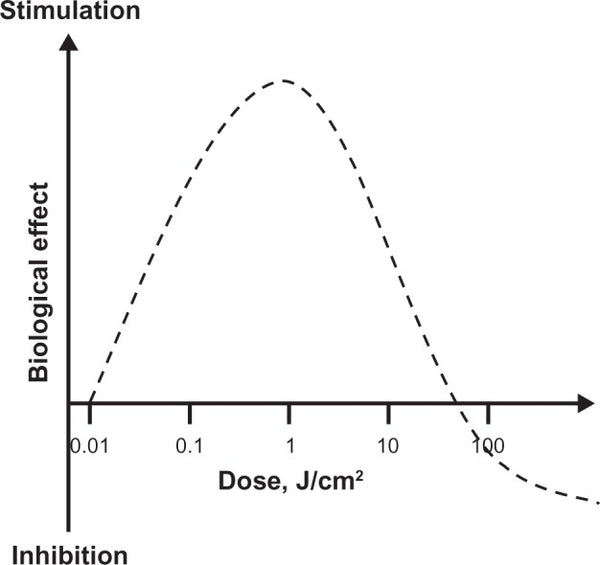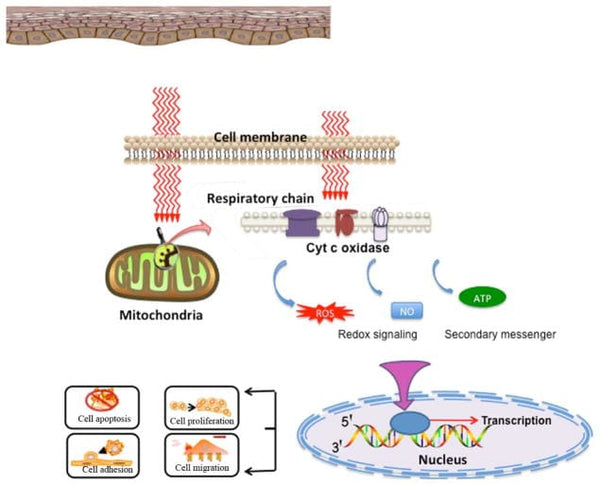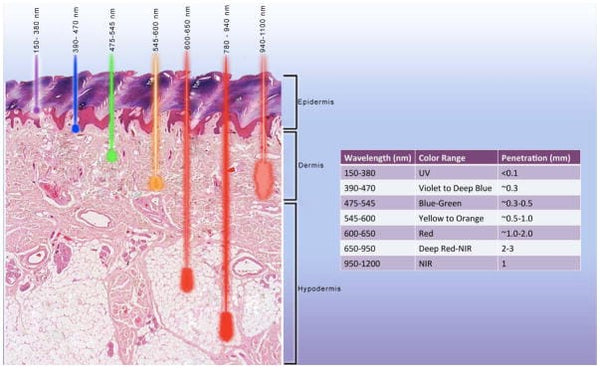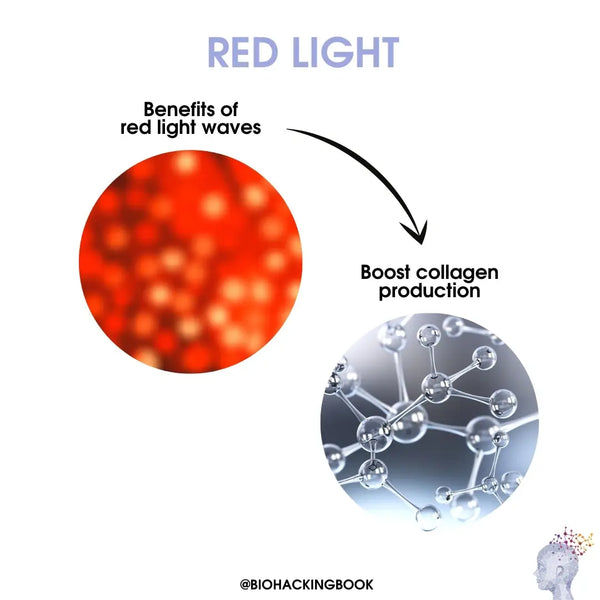Red light and near-infrared light therapy, or photobiomodulation, can improve tissue and skin health, increase muscle recovery, support nervous system health, increase general energy, and reduce pain and inflammation. Just 5 minutes a day is enough! Learn more about Biohacker's red light devices here.
The sources of light (sun, the stars, and the moon) have been worshipped in different cultures throughout human history. Light, whether artificial or natural, does not only give us awe-inducing experiences but also guides biological processes in the body, for example, circadian rhythms.
Introduction
I will love the light for it shows me the way, yet I will endure the darkness for it shows me the stars. – Og Mandino
After the invention of the light bulb in the late 19th century, it was possible to provide light locally to different parts of the body. The invention of laser light in the 1960s made it possible to centralize single-wavelength light and use it for therapeutic applications (LLLT; low-level laser therapy). The new LED light technology has made it possible to replace the soft laser with the most economical LEDs with sufficient luminous efficacy that can narrow the wavelength of light precisely enough.
The link between light and human health has inspired the research in different types of light therapy. Especially within recent years, light devices that emit different wavelengths (colors) of light have been developed. These include red & near-infrared light (NIR) devices that have been noticed to support skin health, wound healing, tissue repair, and even contribute to neural health. This post lists the ways red light & NIR might improve various aspects of health. There are currently over 5000 published research articles on the effect of red light therapy on these effects.
The effects of low-level laser therapy (LLLT) and photobiomodulation are characterized by inverted U-shaped dose-response curves, in which linear responses may be seen only at very low doses. Whereas linear effects may be negligible, maximal stimulatory effects are typically observed at intermediate doses. However, the linear relationship does not hold at high doses, since inhibitory effects are observed instead.

Image: Hormetic effect of photobiomodulation (LLLT; low-level laser therapy).
Source: Rojas, J. & Gonzalez-Lima, F. (2011). Low-level light therapy of the eye and brain. Eye and Brain 3: 49–67.
How photobiomodulation works?
Red light therapy uses light energy which is a form of electromagnetic radiation (EMR). Human cells contain molecules whose functioning can be altered when receiving EMR. Indeed, the uptake of EMR is an important process that enables life on Earth. For example, the eye contains photoreceptors that absorb light and contribute to vision. In addition, some cells contain molecules that are not related to vision per se, but have special molecules that accept light waves (these are called photoacceptors). In these cells, the light waves cause biological chain reactions that contribute to energy production in the cell.
Photobiomodulation is the utilization of non-ionizing photonic energy to trigger photochemical changes within cellular structures that are receptive to photons, particularly in mitochondria. Red light and NIR light therapy is believed to mainly work through photoacceptors – the most important photoacceptor being an enzyme called cytochrome c oxidase.

Red light therapy uses exclusively red- to near-infrared light waves (λ = 600–1100 nm). Red light waves penetrate through the skin and make their way to the cell’s mitochondria where they increase the cells’ energy production. There are various events that lead to this, for example, acceleration of mitochondrial respiration via cytochrome c oxidase. Red light also supports the transcription of new gene products (such as proteins or RNA). Thus, it supports several cellular mechanisms that contribute to healing and cell longevity.
Recently it has been shown that the biochemical effects of photobiomodulation are still present even if the cell does not contain any mitochondria: although metabolic changes are associated with PBM, CCO is not required for its cell proliferation enhancing effect. Nitric oxide (NO) is involved in a number of the reported light effects on CCO.
This has led the researchers to the possibility that the intrinsic nature of PBM involves the production of nitric oxide. The combination of cytochrome c oxidase and hemoglobin/myoglobin NO production with the photorelease of NO may constitute the heart of PBM.
RED LIGHT VS NEAR-INFRARED LIGHT
Red light’s light spectrum is between 630-700 nm. Near-infrared wavelengths on the other hand fall into the invisible part of the light spectrum being 700-1300 nm. Generally, the longer the wavelength, the deeper the penetration into tissues. Different cell and tissue types each have their unique light absorption methods at varying wavelengths (different photoacceptors).
Red light and NIR therapy at home
During the first week use 2 minutes daily. If the device is used for two separate targets (for example to hand and to foot), the operating time is 1.5 minutes each. If needed, the operating time can be increased to 3–5 minutes in the next week and longer if needed per target area. Use of more than 15 minutes is not recommended because red light has a narrow therapeutic window – in other words, longer use time does not increase the effect, but may even reverse it. People react differently to light, so everyone should test the correct distance from the skin and the duration of use. After initial testing, the device can be used 1-2 times a day, sometimes as little as 2-3 times per week is enough. If you want to reach deeper into the subcutaneous tissue, you can apply it a little longer and at a shorter distance to the skin (5-10 cm).
The device has light diodes that emit beams classified as red light or near-infrared light (NIR) or both. Depending on the wavelength of the light, it will penetrate to different depths of the skin surface (NIR penetrates slightly deeper than red light). It’s important to look out for a device that emits wavelengths of light with scientifically supported benefits
- Red light ≈ 660 nm
- Infrared light ≈ 850 nm

Light therapies and their potential applications
|
Type of light therapy |
Wavelength (nm) |
Benefits |
|
Red |
600 - 700 |
Support tissue healing, joint and muscle health, pain reduction, and collagen synthesis |
|
Near-infrared (NIR) |
700 - 1300 |
Generally the same as red light, but goes deeper into tissues therefore being more helpful in joint, muscle and pain therapies. |
|
Blue |
450-495 |
Antimicrobial. Used for acne and sun damage |
|
Green (early research) |
500 - 580 |
Might support calmness and reduce migraines |
|
Heliotherapy (sun exposure therapy) |
Vary |
Support circadian rhythm and vitamin D production. Used for sleep disorders and skin conditions |
|
Bright light therapy |
Vary. The most important aspect is the brightness (> 10 000 lux) |
Support circadian rhythm. Used for Seasonal Affective Disorder (seasonal depression) |

Benefits of red light and near-infrared light therapy
Skin
Red light has been used in cosmetic settings to reduce wrinkles, smoothen the skin and increase skin firmness as red light can increase collagen production and decrease collagen destruction. Collagen is the connective tissue protein in the skin, that keeps the skin elastic and wrinkle-free. Collagen production slows down during natural aging and collagen can be damaged by the sun, toxins, and pollution. Red light is believed to combat the loss of collagen by upregulating epidermal growth factors, lowering skin inflammation, and stimulating various other transport and energy compounds. Together these processes lead to increased skin tissue repair and production.
There are many other ways besides red light to increase collagen production, however, red light is possibly the safest one. That’s because many treatments to the skin require initially damaging the skin surface that then initiates the healing process and collagen production (think derma rolling and chemical peeling). However, these treatments can also lead to adverse side effects such as inflammation. Opposite to this, red light tunnels through the skin causing a wound-healing reaction without the actual wound. Red light has shown to be a safe and effective option for skin damaging methods and thus patient satisfaction rates have been high.
Skin conditions
Some trials conclude that red light can aid in managing skin conditions such as psoriasis, acne, rosacea, Bowen’s disease, basal cell carcinoma, and actinic keratosis. It has also been applied to improve wound healing after a burn, surgery and other medical procedures.
An interesting fact for women
During menopause, the lack of estrogen can lead to degeneration of the connective tissue in the vagina and pelvic floor. There is also preliminary evidence that near-iInfrared light therapy could also be applied to the treatment of vaginal tissues. However, the results are preliminary and the area warrants more research.
Hair
A review study concluded that red light treatment to scalp can stimulate hair growth and prevent hair loss in both men and women. Most likely, the light stimulates the epidermal stem cells in the hair follicle bulge. This shifts the hair follicle into active growth phase (anagen phase) and this can lengthen the natural cycle of hair growth.
Pain and tension
Some studies show that near-infrared light might lower pain. For example, one study demonstrated that 830 nm infrared light to temporal muscles (34 seconds) decreased self-reported tension headache pain in women by 60 %. Additionally, their serotonin (the happy hormone) levels were significantly increased three days after the treatment.
In another study, near infra-red light therapy decreased self-reported pain (measured by the WHO criteria) in patients receiving chemotherapy.
Additionally, a systematic review concluded that near-infrared light therapy and also possibly red light therapy seem to offer short term pain relief from tennis elbow.
Red light to support the brain and the eyes
Red light and near-infrared light has been shown to enhance brain and eye functions. Cells in the nervous system such as in the brain are known for consuming a lot of energy (even 20 % of the body’s total energy expenditure). This means that functions such as memory, planning, emotional processing, and motor behavior are very dependent on well-functioning mitochondria and aerobic respiration.
It’s been shown that and near-infrared light treatment to the neural cells (e.g., when applied transcranially) can equally enhance the mitochondrial functioning in the nervous system (via cytochrome c oxidase). Interestingly, animal studies also demonstrated that red light might also improve other processes such as neurotransmission, gene expression, and cell longevity (via reducing oxidative stress and neuroinflammation).
Similarly to the brain, retinal cells are also highly vulnerable to oxidative damage. Many eye disorders (such as glaucoma and macular degeneration) are associated with mitochondrial dysfunction. Low-level light therapy (red & NIR)might improve optic nerve function and retinal protection.
Photobiomodulation for athletes
Photobiomodulation may also aid elite athletes:it has beneficial effects on muscle mass gain and lowering of inflammation and oxidative stress in the muscles. Due to the promising results in athletic performance, researchers have even raised a discussion of whether photobiomodulation should be permitted in athletic competition.
Another potential benefit is support for sleep. Sleep has an integral role in athletic recovery and performance. In one study, whole-body red-light treatment in the evening for 14-days improved sleep, melatonin levels, and endurance performance of elite athletes.
Red light and weight loss
Studies show that red light therapy may help to tone the body and reduce body fat. In one study, adult men and women who did not change their diet lost on average 2.15 cm around their waist (the treated area) after 4 weeks of red light treatment. In another study, morning red and green light exposure significantly reduced the levels of ghrelin - a hormone that increases feeling of hunger. Other studies also support the use of red light for body contouring.
The recommended duration depends on the parameters of the device. These include:
|
Wavelength (nm, nanometers) |
Distance between wave peaks. The most effective red and near infrared light wavelengths are between 600-1100 nm. |
|
Exposure time |
Time used for exposing skin to the light |
|
Fraction |
Total dose is divided in different treatment sessions (fractions) separated by specific intervals (minutes, hours, days) |
|
Contact type |
Shallow, non-contact or contact |
|
Power (W, watts) |
Amount of energy flowing through the device in a second (J/s). |
|
Irradiance (W/cm2) / power density / Light intensity |
Power per surface area |
Interestingly, it seems that photobiomodulation with red and near-infrared light can have a systemic effect even if a small patch of skin is exposed to the light. For example, one study noticed that red light reduced inflammation systemically, even when the treatment was targeted only to the lower back.
Summary
- There are over 5000 research articles on the benefits of red and near-infrared light (NIR) aka photobiomodulation on human health
- Red light and near-infrared light treatment can improve tissue health, skin health, muscle recovery, and neural health
- Devices are easy to use and safe to do at home, however, the user needs to carefully read instructions and parameters of the light to avoid overdosing it
- Red and NIR work via light energy that improve cellular energy production via an enzyme called a cytochrome C oxidase
- There are many different types of light devices on the market, some more effective than others
- Try photobiomodulation for example to improve and firm the skin, reduce wrinkles, improve athletic performance, upregulate energy, or to support weight loss
Have you tried photobiomodulation and red light terapy? Tell us in the comments!





